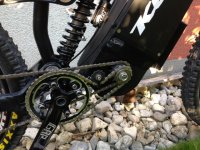recumpence
1 GW
LightningRods said:I think that torque makes everything happen, both good and bad. Take torque out of the equation for horsepower, watts or work and what's left?
I agree that torque breaks inadequate driveline parts. Without exception I say make the driveline better.
You cannot take torque out of the equasion. What you want to do is reduce torque while increasing driveline component speed, the reduce the drive line speed at the final drive at the rear wheel. This will dastically reduce the abusing load on the rear cogs, chain, and frame.
Again, torque is static pressure. If you push against a wall, you are applying torque, while no useable work is being done. Now, push against a car in neutral with the same force (same torque) and the car starts to roll. That movement multiplied by the pressure is measured in watts. A bicycle chain on the pedal side has a low surface speed. That means that to put a certain amount of wattage to the rear wheel will put a relatively high amount of torque on the chain and rear cog to move the bike due to that low chain surface speed.
The key to making light weight components survive is increasing surface speed for a given power output. When surface speed of a component increases (keeping the wattage constant), the torque loading (static pressure) drops. For instance, pushing 3,000 watts through a system geared for 30mph using the largest 34 tooth cog, the chain and sprockets will see a specific torque loading. Now, run the same 3,000 watts at 30mph through a system running a 16 tooth rear cog (making up the gearing difference at the motor pulley) the torque loading on the chain and rear cog will double. This is the benefit to running relatively tall gearing at the drive system and using a very large cog at the rear wheel. The chain speed goes way up and the torque loading on the chain and rear cog drops significantly. In that instance, the torque load is still the same at the wheel, but the chain and rear cog is trading torque for surface speed.
I did not mean to clog up the thread. I was just trying to shed some light on why that suspension link cracked.
Game on!
Matt








